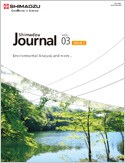Vol.3, Issue1-March 2015 CONTENT
Environmental Analysis
 |
Shimadzu Journal Vol.3, Issue1-March 2015 (1,847 KB) Environmental Analysis |
 |
[Insight from Customer] Professor Kevin A. Schug of the University of Texas at Arlington (Page 4-6) We interviewed Dr. Kevin A. Schug, Associate Professor and Shimadzu Distinguished Professor of Analytical Chemistry in the Department of Chemistry and Biochemistry at the University of Texas at Arlington (UT Arlington). His research is mainly on the separation of bioactive chemical compounds with mass spectrometry techniques.
|
 |
[Environmental Analysis]
About 15% of Americans rely on their own private wells for their drinking water, but unlike public water systems, these are not subject to either state or federal regulations and are not regularly tested by experts. The use of multiple instruments to analyze groundwater has the advantages of describing groundwater samples more completely than individual measurements, validating measurements, and protecting against reporting false positives. To demonstrate this combinatorial analytical advantage, Shimadzu analytical instruments were used to characterize groundwater samples.
|
 |
[Interview]
We interviewed professor Michihiko Ike from the Division of Sustainable Energy and Environmental Engineering, Graduate School of Engineering, Osaka University, who is involved in cutting-edge research on environmental technologies based on biodiversity.
|
 |
These articles were selected by Shimadzu for this issue. The articles are from application notes and technical reports, relating to environmental analysis and feature a variety of instruments we produce. The cutting-edge technologies are also included. Please obtain the articles of your interest through the links on the titles.
|
 |
[Environmental Analysis]
Hydraulic fracturing is a well-stimulation process used to improve recovery and production of oil and natural gas from unconventional petroleum deposits. Coal bed methane and gas shale are examples of unconventional petroleum deposits that require "fracking". When fracking a well, a large volume of water mixed with sand and chemicals is injected into the formation at pressures high enough to cause the rock to crack. The sand fills the fissures, creating channels that allow the gas
to escape into the pipe. Coal bed methane gas deposits do not require as much water as shale gas deposits. Because shale “fracking” requires millions of gallons of water, there is genuine concern that the environment will be adversely impacted.
|
 |
[Environmental Monitoring]
Environmental water contains a variety of elements, including those related to industrial and agricultural activity and urban waste. In efforts to manage these pollutants in Asia, the United Nations University (UNU) and Shimadzu Corporation jointly established a capacity-building initiative that would provide Asian countries with the analytical scientific knowledge and technology to monitor pollutants in the environment and better implement multilateral environmental agreements like the Stockholm Convention on POPs.
|
 |
[Topics]
In January 2010, Shimadzu started the "Save the Energy" project to strengthen our lineup of energy-saving products.
This project promotes the development of products that offer the potential of significant energy savings and are consistent with a low-carbon society by achieving energy savings of at least 25 % through lower power consumption by the customer and lower operating costs. |
 |
[Topics]
Shimadzu awarded twice in Innovation Awards - the Analytical Scientist Innovation Awards 2014 (Page 24)
Shimadzu is honored to be recognized by The Analytical Scientist Innovation Awards 2014 for two innovative analytical systems: iMScope Trio imaging mass microscope and the Nexera-e comprehensive two-dimensional liquid chromatograph.
|
 |
[Product Information] |


